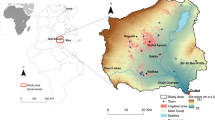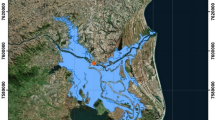Abstract
Population growth and increasing demand for water have posed a significant challenge to access to safe water resources. Climate change and land use in the not-too-distant future add to the complexity of this challenge. Therefore, it is essential to achieve reliable methods for predicting changes in aquifer storage to plan for the sustainable use of groundwater resources. This study aimed to investigate the management, protection, and sustainable use of groundwater resources under climate change and land use change conditions. In this regard, groundwater supply and demand in one of the important plains in Iran (Hashtgerd plain) for 2020 as the base year was simulated to forecast the trends until 2050 by considering climate change and land use to develop management scenarios to adapt to these conditions using the WEAP model. First, climate change prediction was performed using the HadGEM2-ES model under two emission scenarios, RCP2.6, and RCP8.5, of the IPCC Fifth Assessment Report. The LARS-WG model was used to downscale the climatic data, while land use map** was performed using Landsat satellite images of 1990, 2005, and 2020 in ENVI 5.3 software. Then, the Markov chain method implemented in TerrSet software was used to model land use change for 2050. The effect of climate change and land use on the decrease of groundwater level was then simulated using the MODFLOW model for the period 2020–2050. In order to manage the water allocation in the area, the information obtained from MODFLOW was transferred to the WEAP model using Link Kitchen interface software. The effects of various management scenarios such as increasing irrigation efficiency, reducing the loss of drinking water distribution networks, and allocating water from the transmission line were evaluated on the adaptation to climate change and land use for a 30-year period. The results showed that with the simultaneous consideration of climate change and land use in the most critical state, the average drop in groundwater level would reach 58 m during the study period, and aquifer reserves will be reduced by more than 50%. The evaluation of management scenarios showed that their implementation not only will protect aquifer reserves but, in addition to meeting 100% of the water needs, will result in sustainable exploitation of groundwater resources.















Similar content being viewed by others

Availability of data and material
Data and material would be made available on request.
References
Abdollahi K, Bashir I, Verbeiren B, Harouna MR, Van Griensven A, Huysmans M, Batelaan O (2017) A distributed monthly water balance model: formulation and application on Black Volta Basin. Environ Earth Sci 76(5):198
Adhikari RK, Mohanasundaram S, Shrestha S (2020) Impacts of land use changes on the groundwater recharge in the Ho Chi Minh city Vietnam. Environ Res 185:109440
Aggarwal SP, Garg V, Gupta PK, Nikam BR, Thakur PK (2012) Climate and LULC change scenarios to study its impact on hydrological regime. Int Archiv Photogramm Remote Sens Spatial Inf Sci 39(B8):147–152
Ahmadpari H., Tanhapour M., Hajizadeh M., 2016. Estimation of water needs of crops and gardens in Borazjan using CropWat model. The first international conference and the third national conference on environmental engineering and management of environment and sustainable natural resources
Alslevani and Almohseen, 2017. Integrated application (MODFLOW) and (WEAP) Model in Nineveh province. J Univ Duhok; 20(1)(Pure and Eng. Sciences), pp680–690, 2017 eISSN: 2521–4861 and pISSN: 1812–7568. https://doi.org/10.26682/sjuod.2017.20.1.59
Arsanjani JJ, Helbich M, Kainz W, Boloorani AD (2013) Integration of logistic regression, Markov chain and cellular automata models to simulate urban expansion. Int J Appl Earth Obs Geoinf 21:265–275
Asadzadeh F, Khosravi Aqdam K, Parviz L, Ramazanpour H, Yaghmaeian Mahabadi N (2018) Prediction of the land use change using markov chain and cellular automata (case study: Roze Chay basin, Uremia). J Soil Water Resources Conserv 8(1):105–116
Bahri M (2013) Evaluation of the effects of climate change and land use on hydrological reactions of watersheds (Case study: Eskandari watershed, Isfahan province). Master Thesis, Faculty of Natural Resources, Yazd University
Batelaan O, De Smedt FL (2001). WetSpass: a flexible, GIS based, distributed recharge methodology for regional groundwater modelling. IAHS PUBLICATION, pp 11–18
Birhanu A, Masih I, van der Zaag P, Nyssen J, Cai X (2019) Impacts of land use and land cover changes on hydrology of the Gumara catchment, Ethiopia. Phys Chem Earth, Parts a/b/c 112:165–174
Crosbie RS, Scanlon BR, Mpelasoka FS, Reedy RC, Gates JB, Zhang L (2013) Potential climate change effects on groundwater recharge in the High Plains Aquifer, USA. Water Resour Res 49(7):3936–3951
Dau QV, Momblanch A, Adeloye AJ (2021) Adaptation by himalayan water resource system under a sustainable socioeconomic pathway in a high-emission context. J Hydrol Eng 26(3):04021003
Dehghanipour AH, Zahabiyoun B, Schoups G, Babazadeh H (2019) A WEAP-MODFLOW surface water-groundwater model for the irrigated Miyandoab plain, Urmia lake basin, Iran: multi-objective calibration and quantification of historical drought impacts. Agric Water Manag 223:105704
Dehghanipour AH, Schoups G, Zahabiyoun B, Babazadeh H (2020a) Meeting agricultural and environmental water demand in endorheic irrigated river basins: a simulation-optimization approach applied to the Urmia Lake basin in Iran. Agric Water Manag 241:106353
Dehghanipour AH, Moshir Panahi D, Mousavi H, Kalantari Z, Tajrishy M (2020b) Effects of water level decline in Lake Urmia, Iran, on local climate conditions. Water 12(8):2153
Ehteshami M, Aghasi A, Rezaei RA (2002) Investigating the evolution of groundwater potential in Hashtgerd plain in the last ten years and its causes. J Environ Sci Technol 4(2):61–74 ((In Persian))
Han JC, Huang Y, Zhang H, Wu X (2019) Characterization of elevation and land cover dependent trends of NDVI variations in the Hexi region, northwest China. J Environ Manage 232:1037–1048
Hojjati MH, Boustani F (2010) An assessment of groundwater crisis in Iran case study: fars province. Int J Hum Soc Sci 4(10):2066–2070
Höllermann B, Giertz S, Diekkrüger B (2010) Benin 2025-Balancing future water availability and demand using the WEAP “Water evaluation and planning” system. Water Resour Manag 24:3591–3613. https://doi.org/10.1007/s11269-010-9622-z
Ildormi AR, Nori H, Naderi M, Aghbeigi A, Zeinivand H (2015) Land use change prediction using markov chain and ca markov model (case study: Gareen Watershed). J Watershed Manage Res 8(16):232–240
Islam K, Rahman MF, Jashimuddin M (2018) Modeling land use change using cellular automata and artificial neural network: the case of Chunati Wildlife Sanctuary, Bangladesh. Ecol Ind 88:439–453
Kinati C, Shoeb Q, Asfaw K and Tena A (2019) Effect of land use land cover and climate change on river flow and soil loss in Didessa River Basin, South West Blue Nile, Ethiopia. Hydrology 6(2). https://doi.org/10.3390/hydrology6010002
Lamichhane S, Shakya NM (2020) Shallow aquifer groundwater dynamics due to land use/cover change in highly urbanized basin: the case of Kathmandu Valley. J Hydrol Reg Stud 30:100707
Mango LM, Melesse AM, McClain ME, Gann D, Setegn S (2011) Land use and climate change impacts on the hydrology of the upper Mara River Basin, Kenya: results of a modeling study to support better resource management. Hydrol Earth Syst Sci 15(7):2245–2258
Marhaento H, Booij MJ, Hoekstra AY (2018) Hydrological response to future land use change and climate change in a tropical catchment. Hydrol Sci J 63(9):1368–1385
Mehrazar A, Massah Bavani A, Mashal M, Rahimikhoob H (2018) Assessment of climate change impacts on agriculture of the Hashtgerd Plain with emphasis of AR5 models uncertainty. Irrig Sci Eng 41(3):45–59
Mohammadmirzaei F, Zakerinia M, Hezarjaribi A (2020) Evaluation of different scenarios of water resources management in the gorganroud basin using WEAP and MODFLOW models. J Water Soil Sci 24(2):137–152
Mohammadrezapourtabari M., Morsali M., Nouri H. (2008). Locating susceptible areas for the implementation of artificial aquifer recharge plans using GIS (Case study: Hashtgerd plain), 4th National Congress on Civil Engineering, University of Tehran, Tehran, Iran (In Persian)
Mortazavizadeh FS, Godarzi M (2018) Evaluation of climate change impacts on surface runoff and groundwater using HadGEM2 climatological model (case study: Hashtgerd). J Water Soil 32(2):433–446
Naouel D (2021) Planning and management of water resources in the context of economic devlopment and climate change in algerian highlandsby the WEAP model, case of the gareat El Tarf Basin (Northwestern Algeria). Civ Environ Eng Rep 31:200–215. https://doi.org/10.2478/ceer-2021-0015
Nayyeri M, Hosseini SA, Javadi S, Sharafati A (2021) Spatial differentiation characteristics of groundwater stress index and its relation to land use and subsidence in the Varamin Plain. Iran Nat Resour Res 30(1):339–357
Noszczyk T (2019) A review of approaches to land use changes modeling. Hum Ecol Risk Assess Int J 25(6):1377–1405
Olabanji MF, Ndarana T, Davis N, Archer E (2020) Climate change impact on water availability in the Olifants catchment (South Africa) with potential adaptation strategies. Phys Chem Earth Parts a/b/c 120:102939
Omranian Khorasani H, Davary K, Bagheri A, Gheisani E (2014) Implementation of strategic water resources management; a proposed framework utilizing "road map"tool. J Water Sustain 1(2):101–112
Purandara BK, Venkatesh B, Jose MK, Chandramohan T. (2018). Change of land use/land cover on groundwater recharge in Malaprabha Catchment, Belagavi, Karnataka, India. In: Groundwater. Springer, Singapore, pp 109–120
Raskina P, Hansen E, Zhu Z, Stavisky D (1992) Simulation of water supply and demand in the Aral sea region. Water Int 17(2): 55–67. https://doi.org/10.1080/02508069208686127
Regional Water Company of Tehran (2011) Geology, semi-detailed studies of Hashtgerd Plain. Iran Water Resources Management Company, Ministry of Energy (In Persian)
Regional Water Company of Tehran (2013) Updating water resources studies report of Namak Lake basin. Iran Water Resources Management Company, Ministry of Energy (In Persian)
Salehi N, Ekhtesasi MR, Talebi A (2019) Predicting locational trend of land use changes using CA-Markov model (Case study: Safarod Ramsar watershed). J RS GIS Nat Resour 10(1):106–120
Salt Lake catchment report (2006) Ministry of energy, water resources management organization, office of basic studies of water resources (In Persian).
Satiprasad S, Anirban D, Anupam D, Biswajeet P, Abdullah M (2020) Future water use planning by water evaluation and planning system model. Water Resources Manage. https://doi.org/10.1007/s11269-020-02680-8
Sieber J, Purkey D (2015) WEAP water evaluation and planning system: userguide. Stockholm Environment Institute, US Center
Semenov MA, Stratonovitch P (2010) Use of multi-model ensembles from global climate models for assessment of climate change impacts. Climate Res 41(1):1–14
Tam VT, Batelaan O, Beyen I (2016) Impact assessment of climate change on a coastal groundwater system, Central Vietnam. Environ Earth Sci 75(10):908
Tamm O, Maasikamäe S, Padari A, Tamm T (2018) Modelling the effects of land use and climate change on the water resources in the eastern Baltic Sea region using the SWAT model. CATENA 167:78–89
Tarawally M, Wenbo X, Weiming H, Mushore TD, Kursah MB (2019) Land use/land cover change evaluation using land change modeller: A comparative analysis between two main cities in Sierra Leone. Remote Sens Appl Soc Environ 16:100262
Tsarouchi G, Buytaert W (2018) Land use change may exacerbate climate change impacts on water resources in the Ganges basin. Hydrol Earth Syst Sci 22(2):1411–1435
Yates D, Sieber J, Purkey D, Huber-Lee A (2005) WEAP21 - A demand-, priority-, and preference-driven water planning model. Part 1: model characteristics. Water Int 30:487–500. https://doi.org/10.1080/02508060508691893
Funding
No funding for this research.
Author information
Authors and Affiliations
Contributions
AH: methodology, software code, validation, formal analysis, writing, original draft. SAH: investigation including data collection and calibration, and writing, reviewing and editing. SJ and AS: writing, reviewing and editing.
Corresponding author
Ethics declarations
Conflict of interest
The authors declare no competing interests.
Consent to participate
The manuscript has been read and approved by all named authors and there are no other persons who satisfied the criteria for authorship but are not listed. The order of authors listed in the manuscript has been approved by all of the authors.
Additional information
Edited by Dr. Achilleas Samaras (ASSOCIATE EDITOR) / Dr. Michael Nones (CO-EDITOR-IN-CHIEF).
Rights and permissions
About this article
Cite this article
Hanifehlou, A., Hosseini, S.A., Javadi, S. et al. Sustainable exploitation of groundwater resources considering the effects of climate change and land use to provide adaptation solutions (case study of the Hashtgerd plain). Acta Geophys. 70, 1829–1846 (2022). https://doi.org/10.1007/s11600-022-00843-2
Received:
Accepted:
Published:
Issue Date:
DOI: https://doi.org/10.1007/s11600-022-00843-2



